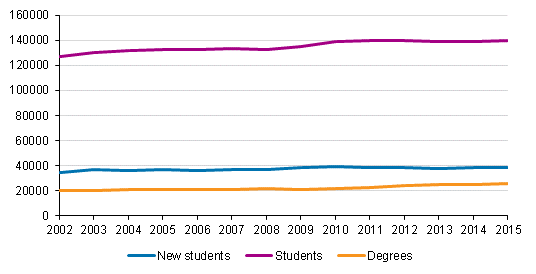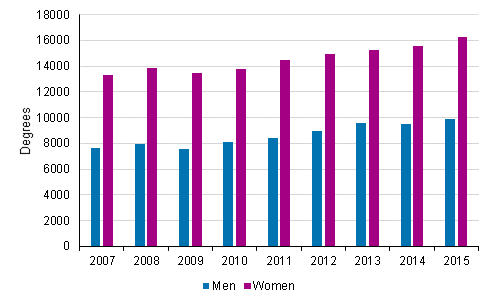This set of statistics has been discontinued.
Statistical data on this topic are published in connection with another set of statistics.
Data published after 5 April 2022 can be found on the renewed website.
Published: 19 April 2016
Numbers of polytechnic students and degrees are rising
According to Statistics Finland's Education Statistics, nearly 130,000 students attended education leading to a polytechnic degree and around 10,000 students education leading to a higher polytechnic degree in 2015. The number of polytechnic degrees completed was 23,800 and that of higher polytechnic degrees 2,400. The numbers of both students and degrees rose slightly from the year before.
Students and completed degrees in polytechnics in 2002 to 2015

Polytechnic studies in daytime and multiform programmes
A polytechnic degree can be studied in education arranged as daytime or multiform studies from 2015 onwards. A total of 106,300 students studied in daytime programmes and 23,300 in multiform programmes. Before this, polytechnic education was arranged for young people and as adult education.
Fifty-three per cent of the students attending education leading to a polytechnic degree and 64 per cent of the students attending education leading to a higher polytechnic degree were women.
At 30 per cent of all students, there were most students in education leading to a polytechnic degree in the field of technology and transport. Of them, 86 per cent were men. The second largest field was the female-dominated field of health, welfare and sports, which 29 per cent of polytechnic students attended. Twenty-one per cent of the students were studying in the third largest field of social sciences, business and administration.
The number of students was highest in education leading to a higher polytechnic degree in the field of health, welfare and sports, 32 per cent. Altogether, 27 per cent of students were studying in the field of social sciences, business economics and administration and 24 per cent in the field of technology and transport.
The number of students was highest at Helsinki Metropolia University of Applied Sciences, 16,300, and the second highest at Haaga-Helia University of Applied Sciences, 10,200. The next most students were studying at Tampere and Turku Universities of Applied Sciences, around 9,500 in both. The smallest polytechnic was the Police College of Finland with 460 students.
Women completed more than 60 per cent of all degrees
Of polytechnic degrees, most degrees were completed in the field of social services, health and sports, 34 per cent. Eighty-seven per cent of them were completed by women. The second most degrees were completed in the technology and transport sector, 24 per cent. Of these degrees, four out of five were completed by men. The number of degrees completed was third highest, 21 per cent, in the field of social sciences, business economics and administration. Women completed 67 per cent of these degrees. Sixty-one per cent of all polytechnic degrees were completed by women.
Completed polytechnic degrees by gender from 2007 to 2015

Most higher polytechnic degrees were completed in the field of health, welfare and sports, 37 per cent, and second most in the field of social sciences, business and administration, 24 per cent. Women completed 69 per cent of all higher polytechnic degrees.
The highest number of degrees was attained at Helsinki Metropolia University of Applied Sciences, 2,900, and the lowest at the Police University College, 30. More detailed time series data on polytechnic students and degrees by education and polytechnic, for example, are available in the tables in databases .
Source: Education. Statistics Finland
Inquiries: Anna Loukkola 029 551 3678, koulutustilastot@stat.fi
Director in charge: Jari Tarkoma
Publication in pdf-format (209.0 kB)
- Tables
-
Tables in databases
Pick the data you need into tables, view the data as graphs, or download the data for your use.
Appendix tables
Updated 19.04.2016
Official Statistics of Finland (OSF):
University of applied sciences education [e-publication].
ISSN=2489-3196. 2015. Helsinki: Statistics Finland [referred: 17.1.2026].
Access method: http://stat.fi/til/akop/2015/akop_2015_2016-04-19_tie_001_en.html

